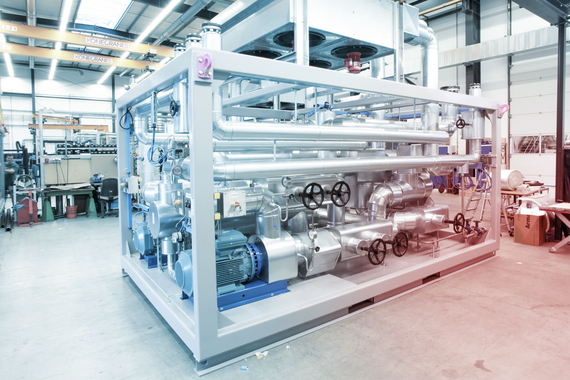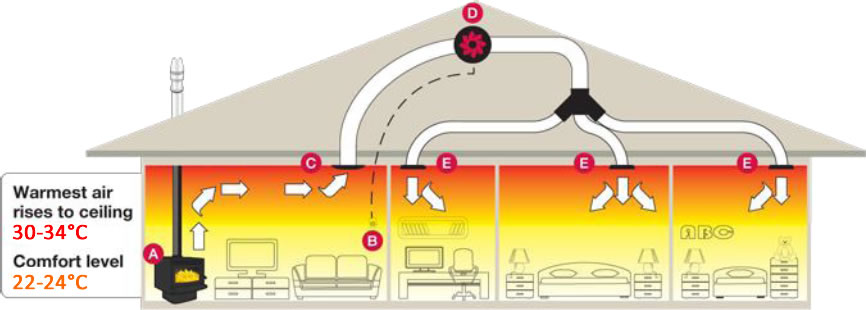DVS Heat Transfer Systems: The Future of Energy-Efficient Industrial Heating Solutions
Wiki Article
The Function of Heat Transfer Solutions in Sustainable Energy Solutions for the Future
Heat transfer systems are vital in the pursuit for lasting power options. They enhance thermal energy management, enhancing the effectiveness of sustainable innovations. By utilizing systems like radiation, transmission, and convection, these systems reduce energy losses. Their function in solar thermal and geothermal applications is particularly substantial. As developments emerge, the possibility for additional developments elevates essential questions regarding future power methods. What developments will form the landscape of sustainable energy?Comprehending Heat Transfer Equipments

The Value of Thermal Power Management
Efficient thermal energy administration is essential for taking full advantage of power efficiency and lessening waste in various systems. By controling temperature level and optimizing Heat transfer procedures, organizations can substantially decrease power intake and operational expenses. Reliable management entails the application of innovative innovations and practices that check and regulate thermal conditions within systems, ensuring that energy resources are used successfully. On top of that, correct thermal energy management adds to lowering greenhouse gas discharges, straightening with international sustainability objectives. It likewise improves system integrity and performance, causing boosted product quality and longer equipment life expectancy. Ultimately, focusing on thermal power administration is a vital step in the direction of creating extra lasting energy solutions and fostering a responsible strategy to energy usage in commercial and residential contexts.Applications of Heat Transfer in Renewable Resource
While different renewable energy resources assure sustainability, the effective application of Heat transfer plays an important role in their effectiveness. In wind power systems, Heat transfer is used for wind turbine part cooling, enhancing efficiency and durability. Geothermal energy relies on reliable Heat exchange in between the earth's subsurface and the liquid flowing in the system, maximizing power extraction. Biomass power processes additionally gain from Heat transfer, as it aids in transforming organic products right into usable gas through pyrolysis and gasification. Furthermore, in hydropower, preserving optimal temperature levels in storage tanks can enhance power outcome. Each of these applications shows the important relevance of Heat transfer systems in enhancing renewable power technologies, inevitably adding to a more lasting energy future.Enhancing Solar Thermal Power Efficiency
As solar thermal power systems proceed to develop, boosting their effectiveness has actually ended up being important for taking full advantage of energy outcome. Advances in Heat transfer modern technologies, such as enhanced thermal storage space materials and ingenious Heat exchangers, play a significant duty in improving efficiency. By utilizing sophisticated products that have superior thermal conductivity, systems can move and capture Heat much more efficiently. Additionally, incorporating radar that follow the sunlight's course guarantees that collection agencies receive suitable solar direct exposure throughout the day. Utilizing nanotechnology in solar absorbers can additionally increase power absorption prices. Incorporating automatic control systems helps manage temperature levels and take care of energy distribution successfully, leading to lowered losses and boosted total system effectiveness. These enhancements lead the way for even more sustainable solar thermal energy solutions in the future.Geothermal Heating: A Lasting Remedy
Geothermal heating provides a sensible alternative for lasting power, offering considerable ecological benefits via reduced greenhouse gas emissions. Its effectiveness and cost-effectiveness make it an attractive alternative to traditional heating unit. However, challenges connected to execution needs to be dealt with to optimize its possible effect.Ecological Benefits of Geothermal
Traditional heating approaches add significantly to greenhouse gas emissions, geothermal heating presents a compelling alternative that reduces environmental effect. By taking advantage of the Planet's interior Heat, geothermal systems use a renewable power resource, noticeably decreasing reliance on fossil gas. This method creates minimal carbon discharges, making it a cleaner alternative for residential and commercial home heating. Additionally, geothermal systems promote energy effectiveness, as they call for less energy contrasted to standard home heating systems. DVS Heat Transfer Systems. The usage of geothermal power additionally aids in reducing air pollution, boosting neighborhood air quality and public health. As a sustainable service, geothermal home heating sustains climate modification reduction initiatives, placing itself as a vital element in the change towards a greener futureEfficiency and Cost-Effectiveness
How does geothermal heating measure up in regards to effectiveness and cost-effectiveness contrasted to typical heater? Geothermal home heating shows remarkable effectiveness, usually accomplishing a coefficient of performance (COP) of 3 to 5, meaning it produces 3 to 5 devices of Heat for each system of electrical power consumed. This efficiency equates right into reduced operating expense, particularly in regions with secure geothermal resources. First installment expenses can be greater than standard systems; nonetheless, long-lasting savings on power costs and minimized upkeep expenditures can balance out these in advance financial investments. Furthermore, several federal governments incentivize geothermal systems with rebates and tax obligation credit scores, improving their cost-effectiveness. In general, geothermal heating becomes a sustainable and financially viable option to even more conventional home heating services.Execution Difficulties and Solutions
Numerous obstacles can hinder the prevalent implementation of geothermal heating unit, despite their clear benefits as a sustainable power service. High first installation expenses frequently prevent investors and house owners, making funding a substantial obstacle. In addition, the geographical constraints of suitable geothermal websites restrict access in specific areas. Neighborhood policies and permitting processes can likewise make complex job growth, resulting in hold-ups. Public awareness and understanding of geothermal systems continue to be reduced, preventing approval. To address these obstacles, targeted education and learning campaigns can enhance open secret, while government rewards might alleviate financial worries. Teaming up with local authorities to simplify regulations may promote smoother project approvals, eventually promoting the adoption of geothermal heating as a viable, sustainable energy option.Advancements in Heat Transfer Technologies
Technologies in Heat transfer modern technologies play a vital function in enhancing energy effectiveness and sustainability. Advanced Heat exchangers and phase change materials go to the forefront of these advancements, providing significant improvements in thermal monitoring. These modern technologies not just enhance power usage yet also add to minimizing environmental impact in various applications.Advanced Heat Exchangers
Advanced Heat exchangers play a vital duty in boosting energy efficiency across numerous applications in sustainable energy remedies. These gadgets help with the transfer of Heat in between two look at these guys or more liquids, substantially minimizing energy intake in processes such as industrial home heating, air conditioning, and power generation. Developments in materials and style, such as using nanofluids and compact setups, have brought about enhanced thermal efficiency and minimized size demands. Additionally, improvements in digital surveillance go and control systems enable maximized operation, more boosting performance. By lessening waste Heat and maximizing energy recuperation, progressed Heat exchangers add to decrease carbon footprints and sustain the shift toward environmentally pleasant innovations. Their proceeded growth is important for attaining worldwide power sustainability goals.
Phase Adjustment Products
The integration of stage change materials (PCMs) into Heat transfer innovations stands for a significant innovation in power monitoring and effectiveness. PCMs absorb and release thermal energy during their phase modifications, making it possible for effective temperature policy in building products and power systems. By saving excess Heat during height durations and releasing it when demand boosts, PCMs contribute to load changing and power preservation - DVS Heat Transfer Systems. This capacity enhances the performance of renewable energy systems, particularly in solar thermal applications. Furthermore, PCMs can enhance the thermal convenience of indoor environments, decreasing reliance on conventional heating and cooling methods. As developments in PCM formulas continue to emerge, their role in sustainable power solutions is poised to expand, using appealing opportunities for future research study and application
Future Leads for Heat Transfer in Sustainable Energy
As the need for lasting power services proceeds to climb, the role of Heat transfer systems is becoming significantly vital in shaping future innovations. Developments in layouts and products are expected to enhance effectiveness in Heat transfer, lowering energy losses in various applications. The combination of sophisticated thermal storage space systems, such as stage modification materials and thermochemical storage, will allow much better administration of energy resources. Research study right into nanofluids and biomimetic Heat exchangers may additionally enhance thermal efficiency. The adoption of smart technologies will certainly permit for real-time surveillance and flexible control of Heat transfer processes. These developments are poised to significantly contribute to the total effectiveness and sustainability of energy systems, leading the way for an extra energy-efficient future.Regularly Asked Concerns
Exactly How Can Individuals Apply Heat Transfer Solution in your home?

Individuals can implement Heat transfer systems at home by installing energy-efficient devices, using radiant heat, and enhancing insulation. These steps enhance power effectiveness, decrease prices, and advertise sustainable techniques in household atmospheres.

What Are the Prices Associated With Setting Up Heat Transfer Systems?
The costs related to mounting Heat transfer systems differ extensively, generally encompassing devices, setup labor, and maintenance. Elements such as system type, home size, and regional laws substantially affect the total expense involved.Are There Government Incentives for Heat Transfer System Installations?
Federal government motivations for Heat transfer system installations vary by area and can consist of tax credit scores, gives, and rebates. These economic benefits aim to urge adoption, inevitably advertising energy performance and minimizing environmental influence within neighborhoods.Just How Do Heat Transfer Systems Influence Power Bills?
Heat transfer systems notably affect energy bills by maximizing power effectiveness. By improving the transfer of Heat, these systems minimize power usage, resulting in reduced utility expenses and creating a much more sustainable method to energy management.What Maintenance Is Needed for Heat Transfer Equipments?
Maintenance for Heat transfer systems includes routine examinations, cleaning this post of elements, checking fluid degrees, ensuring correct insulation, and changing worn components. These jobs help keep efficiency, prevent malfunctions, and prolong the system's operational life-span.These systems facilitate the motion of thermal power from one medium to an additional, enabling the transfer of Heat for air conditioning, power, or heating generation purposes. Geothermal power depends on efficient Heat exchange between the earth's subsurface and the fluid circulating in the system, maximizing power extraction. Additionally, geothermal systems promote energy effectiveness, as they need much less power compared to standard home heating systems. Advanced Heat exchangers play a vital function in improving power effectiveness across different applications in lasting energy options. Heat transfer systems significantly influence energy costs by maximizing power performance.
Report this wiki page